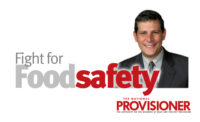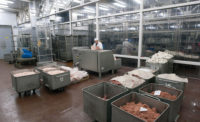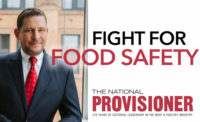POST-PACKAGING PASTEURIZATION
Pathogens Beware
By Lisa White, Contributing writer
With food recall incidences on the rise, the use of post-packaging pasteurization and irradiation are growing in popularity.
As food safety remains at the forefront of the meat packaging industry, many are taking a closer look at the benefits of post-packaging pasteurization.
The concept of post-packaging pasteurization, also called PPP, has been around since the late 1980s, when ready-to-eat products became more prevalent. It was discovered that these meats were being exposed to pathogens following the initial cooking cycle when further processing, like slicing or glazing, was taking place.
After a number of product recalls in the late 1990s, retailers including Wal-Mart and Costco set forth initiatives requiring that their meat products undergo PPP.
This segment was brought to the forefront again in late 2002, when the U.S. Department of Agriculture tightened its Listeria regulations.
“The primary purpose of the PPP process is to reduce microorganism levels on all meat surfaces that may have been contaminated during further processing,” says Dr. Margaret Hardin, associate professor of food microbiology, meat science, at Texas A&M University.
The most widely used methods of PPP in the meat industry are hot water and steam baths, high-pressure pasteurization, and the less common method of irradiation. “Most of these technologies are for application to the product immediately after packaging or as they enter the final package,” Hardin explains. Each of these pathogen-killing tools has its pros, cons and limitations.
Hot water and steam
Both hot water and steam pasteurization for packaged products involve the application of heat at a predetermined temperature for a specified amount of time. This most often is applied in a tunnel or chamber followed by exposure to a chilling system, such as salt water or glycol, to quickly reduce the product’s temperature before the heat reaches its center, Hardin explains.
According to Dr. Kay Cooksey, professor and Cryovac-endowed chair at Clemson University in South Carolina, “Cooling time is critical in this process [to keep pathogens at bay].”
A similar method, flash-pasteurization is a specialized packaging system designed to surface-pasteurize the product just before it is packaged using 200 F steam.
These methods are most effective when product surfaces are exposed and accessible, in the case of whole ham and turkey breast.
Products that are more sensitive to heat would not be able to stand up as well to the steam or hot water processes, Hardin says. For example, water baths are typically used for pasteurizing processed meat, deli and foodservice items. This technique also is very effective on cured meats or those containing nitrates.
It is important to note that PPP must be used at higher levels on all-natural products to be effective, since these meats are more susceptible to microbes, Hanson notes.
In addition, because these processes require additional labor and costs, they tend to be used for more value-added or high-end meat products. Yet, both hot water and steam applications are more popular than high pressure pasteurization because these methods are less expensive and the equipment is more available, Cooksey explains.
“We are finding water baths, in particular, have become more popular with chicken than in the past, due to increased incidences of salmonella,” Cooksey says.
Listeria log reductions range from three to five with these methods, depending on the product. This application, when done correctly, eliminates Listeria and Salmonella that may be present after post processing.
Experts contend that, under ideal circumstances, hot water and steam PPP don’t affect product quality or texture. In fact, less additives and preservatives are necessary for further processed products that undergo PPP, Cooksey notes.
In addition, product needs to be stripped out of its original packaging and repackaged in material that withstands these heat applications. “Certain heat treatments can alter packaging material, so in the interest of extending shelf life, the proper packaging should be used during these processes,” according to Cooksey.
Bob Hanson, principal at HansonTech, a consultancy based in Overland Park, Kan., says there has been increasing interest in cook in the bag pasteurization. “This is when product is cooked in its package at high temperatures in order to inactivate microorganisms. When this is accomplished, further pasteurization is not needed,” he says.
While PPP is geared for kills of three logs or less, cooking product is lethal to six logs.
The popularity of hot water PPP has increased, specifically in the last five to six years, Hanson notes.
During this period, the method has been refined and perfected. “There has been a lot of work done to get better control of the process,” says James Marsden, regents distinguished professor of animal sciences at Kansas State University in Manhattan, Kan. “When the process was first used, it was thought the products needed to be almost recooked to eliminate bacteria. That’s changed quite a bit. Now technology is more directed to killing pathogens with equipment that better controls product temperatures.”
High-pressure pasteurization
Although less prevalent and more costly, high-pressure pasteurization (HPP) is an option for products with less accessible surfaces, such as sliced meats and layered hot dogs.
This PPP method is accomplished by subjecting packaged meat products to high pressures to kill any present bacteria. According to Hardin, HPP involves the application of elevated pressure, up to 700 MPa, with or without the addition of heat. “As with any other processing method, HPP cannot be applied to all food products. For any of these technologies, shelf life and product quality tests must be performed to insure that correct, time, temperature and/or pressure are selected to better insure product safety while maintaining quality,” he says.
Marsden notes that this process has become more popular over the last couple of years for ready-to-eat meat products and because of its versatility.
The biggest advantage offered by HPP is that the nature of the food, including texture, taste and quality, remains unchanged. However, this is a highly technical process that can be quite costly to perform.
Because of this, there are a handful of companies that provide HPP services on a contract basis for processors.
Irradiation
Although less commonly used than hot water, steam and high pressure, irradiation is an effective PPP method when used in high doses.
Irradiation has been around since the 1970s, and was initially used for sterilizing medical equipment.
In 2000, Schwann’s began irradiating its meat, along with Omaha Steaks. At that time, Sure Beam was the provider of this technology and application.
The irradiation segment took a hit in January 2003 when Sure Beam went bankrupt. This method also was fraught with consumer fears that it was unsafe.
Adding to the challenges is the fact that, in order to achieve a six log reduction of pathogens to reach the proper pasteurization levels, irradiation requires very high doses.
Yet, despite the fact that this is a mature process, irradiation technology has made incremental advances in productivity and efficiencies using variable frequency drives and other leading edge components, along with computer monitoring equipment. “In the last 10 years, we have made an investment in the development of irradiation design specifically for food,” says Richard Wiens, global brand manager, sterilization, at MDS Nordion, an irradiation services provider based in Ottawa, Ontario, Canada.
According to Dennis Olson, professor of animal science in charge of the linear accelerator facility at Iowa State University, “From 2002 to 2005, the incidences of E. coli in ground beef were declining. But since 2005, we’ve been noticing some increases in positive results. In first half of 2007 alone, there were 15 cases of E. coli, with some resulting in significant product recalls,” he says. Consequently, the Wegmans supermarket chain has recently started irradiating its ground beef and other retailers are beginning to follow its lead.
Despite these issues in the meat industry, the most common application for irradiation is for produce disinfestations. “The dose needed to kill pathogens in meat, including E. coli, Listeria and Salmonella, are 10 times higher than those needed to take care of fruit flies in produce,” says Wiens.
There appears to be more acceptance among consumers of irradiation techniques that use electrons as opposed to radioactive materials, Marsden notes.
Still, some experts question whether high levels of radiation can negatively affect food flavor and quality. “I would say it may be more effective to use this method to assist in killing pathogens and not for pasteurization,” Marsden says.
Irradiation may also gain more momentum if it is declassified as a food additive by the USDA. Currently, the U.S. government defines X-rays, radiation and Cobalt 60 as food additives. “Before this can occur, the government needs to distinguish between methods that use electrons and the type that uses radioactive materials,” Marsden says.
Dr. David Acheson, assistant commissioner for food protection at the Food & Drug Administration (FDA), says there is a lot of misinformation circulating about irradiation. “I think there is a misconception in consumer education about what irradiation is and what it’s doing, and more importantly, what it’s not. I think establishing the science behind proving that irradiation is all good and not bad is critical, and then further communicating that to the public is key,” he says.
One of the hardest messages to deliver to consumers is to get them to understand “relative risk.” “Everyone’s risk-averse, and I may be oversimplifying, but I think there is a section of the community that sees irradiation as replacing one risk with another. So it’s a really complex issue of communicating relative risk and risk reduction to consumers, because consumers want no risk. They want to eat something with a guarantee that they won’t get sick,” Acheson says.
What does the future hold for irradiation? Olson predicts this technology will be expanded and improved in the coming years. “The other thing we have been waiting eight years for is approval by the FDA for irradiation to be used with ready-to-eat products. This would expand the amount of products available for this application. When this occurs, there will be more interest in irradiation,” he says.
Wiens says there also is an FDA proposed rule in how irradiation products are labeled. “If a product has been irradiated, there is no material change and the manufacturer is not making a change, then the food item does not need to be labeled as irradiated,” he says.
In terms of up-and-coming innovations, Hanson says one of the most exciting trends is in-packaging pasteurization, or turning raw product that may harbor bacteria into packaged cooked product that is pathogen free. “The problem is the kill step with the cooking step in the middle makes it a challenge to keep things really clean. But the beauty of in-packaging pasteurization is product is treated and partially cooked, so it can be handled,” he says. “This is a safer process because pasteurizing and cooking are accomplished in the same package simultaneously. If we can figure out how to do that with more products, we would be in a better place.”
Meat processors who become more familiar with the many pasteurization options, including hot water baths, steam, high pressure and irradiation, will be better able to provide the safest products possible. In addition, having a program like this in place helps decrease the possibility of a costly and damaging product recall.


